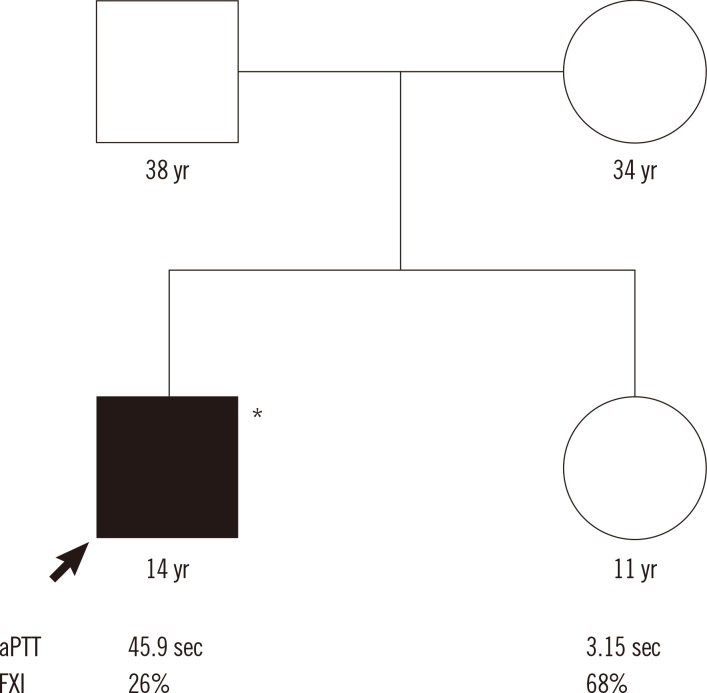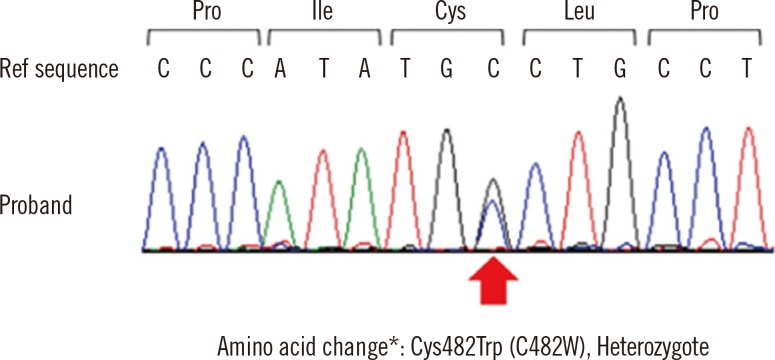Ann Lab Med.
2014 Jul;34(4):332-335. 10.3343/alm.2014.34.4.332.
Cys482Trp Missense Mutation in the Coagulation Factor XI Gene (F11) in a Korean Patient with Factor XI Deficiency
- Affiliations
-
- 1Department of Laboratory Medicine, Severance Hospital, Yonsei University College of Medicine, Seoul, Korea. jhyooken@gmail.com
- 2Department of Laboratory Medicine, Yonsei University Wonju College of Medicine, Wonju, Korea.
- 3Department of Laboratory Medicine, National Health Insurance Service Ilsan Hospital, Goyang, Korea.
- KMID: 1791945
- DOI: http://doi.org/10.3343/alm.2014.34.4.332
Abstract
- No abstract available.
MeSH Terms
Figure
Reference
-
1. Seligsohn U. Factor XI in haemostasis and thrombosis: past, present and future. Thromb Haemost. 2007; 98:84–89. PMID: 17597996.
Article2. Rosenthal RL, Dreskin OH, Rosenthal N. New hemophilia-like disease caused by deficiency of a third plasma thromboplastin factor. Proc Soc Exp Biol Med. 1953; 82:171–174. PMID: 13037836.
Article3. Seligsohn U. High gene frequency of factor XI (PTA) deficiency in Ashkenazi Jews. Blood. 1978; 51:1223–1228. PMID: 647126.
Article4. Seligsohn U. Factor XI deficiency in humans. J Thromb Haemost. 2009; 7(Suppl 1):84–87. PMID: 19630775.
Article5. Kato A, Asakai R, Davie EW, Aoki N. Factor XI gene (F11) is located on the distal end of the long arm of human chromosome 4. Cytogenet Cell Genet. 1989; 52:77–78. PMID: 2612218.
Article6. Asakai R, Davie EW, Chung DW. Organization of the gene for human factor XI. Biochemistry. 1987; 26:7221–7228. PMID: 2827746.
Article7. Asakai R, Chung DW, Davie EW, Seligsohn U. Factor XI deficiency in Ashkenazi Jews in Israel. N Engl J Med. 1991; 325:153–158. PMID: 2052060.
Article8. Shpilberg O, Peretz H, Zivelin A, Yatuv R, Chetrit A, Kulka T, et al. One of the two common mutations causing factor XI deficiency in Ashkenazi Jews (type II) is also prevalent in Iraqi Jews, who represent the ancient gene pool of Jews. Blood. 1995; 85:429–432. PMID: 7811996.9. Zivelin A, Bauduer F, Ducout L, Peretz H, Rosenberg N, Yatuv R, et al. Factor XI deficiency in French Basques is caused predominantly by an ancestral Cys38Arg mutation in the factor XI gene. Blood. 2002; 99:2448–2454. PMID: 11895778.
Article10. Bolton-Maggs PH, Peretz H, Butler R, Mountford R, Keeney S, Zacharski L, et al. A common ancestral mutation (C128X) occurring in 11 non-Jewish families from the UK with factor XI deficiency. J Thromb Haemost. 2004; 2:918–924. PMID: 15140127.
Article11. Quélin F, Trossaert M, Sigaud M, Mazancourt PD, Fressinaud E. Molecular basis of severe factor XI deficiency in seven families from the west of France. Seven novel mutations, including an ancient Q88X mutation. J Thromb Haemost. 2004; 2:71–76. PMID: 14717969.
Article12. Okumura K, Kyotani M, Kawai R, Takagi A, Murate T, Yamamoto K, et al. Recurrent mutations of factor XI gene in Japanese. Int J Hematol. 2006; 83:462–463. PMID: 16787881.
Article13. Wang J, Wang X, Dai J, Ding Q, Fu Q, Wang H, et al. A case of factor XI deficiency caused by compound heterozygous F11 gene mutation. Haemophilia. 2009; 15:603–606. PMID: 19347998.
Article14. Kim J, Song J, Lyu CJ, Kim YR, Oh SH, Choi YC, et al. Population-specific spectrum of the F11 mutations in Koreans: evidence for a founder effect. Clin Genet. 2012; 82:180–186. PMID: 21668437.
Article15. Mitchell M, Mountford R, Butler R, Alhaq A, Dai L, Savidge G, et al. Spectrum of factor XI (F11) mutations in the UK population--116 index cases and 140 mutations. Hum Mutat. 2006; 27:829. PMID: 16835901.16. Lee JH, Cho HS, Hyun MS, Kim HY, Kim HJ. A novel missense mutation Asp506Gly in Exon 13 of the F11 gene in an asymptomatic Korean woman with mild factor XI deficiency. Korean J Lab Med. 2011; 31:290–293. PMID: 22016685.
Article
- Full Text Links
- Actions
-
Cited
- CITED
-
- Close
- Share
- Similar articles
-
- A Novel Missense Mutation Asp506Gly in Exon 13 of the F11 Gene in an Asymptomatic Korean Woman with Mild Factor XI Deficiency
- Three Cases of Factor XI Deficiency
- Two Cases of Factor XI Deficiency in Sisters
- Anesthetic experience of a patient with hereditary factor XI deficiency (Hemophilia C) : A case report
- Factor XI deficiency and orthognathic surgery: a case report on anesthesia management



